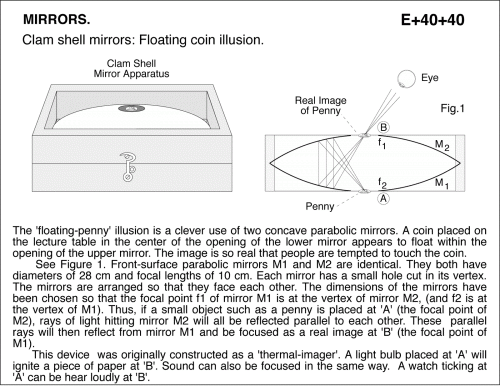Clam shell mirrors: Floating coin illusion.
Primary tabs
Clam shell mirrors: Floating coin illusion. The 'floating-penny' illusion is a clever use of two concave parabolic mirrors. A coin placed on the lecture table in the center of the opening of the lower mirror appears to float within the opening of the upper mirror. The image is so real that people are tempted to touch the coin. See Figure 1. Front-surface parabolic mirrors M1 and M2 are identical. They both have diameters of 28 cm and focal lengths of 10 cm. Each mirror has a small hole cut in its vertex. The mirrors are arranged so that they face each other. The dimensions of the mirrors have been chosen so that the focal point f1 of mirror M1 is at the vertex of mirror M2, (and f2 is at the vertex of M1). Thus, if a small object such as a penny is placed at 'A' (the focal point of M2), rays of light hitting mirror M2 will all be reflected parallel to each other. These parallel rays will then reflect from mirror M1 and be focused as a real image at 'B' (the focal point of M1). This device was originally constructed as a 'thermal-imager'. A light bulb placed at 'A' will ignite a piece of paper at 'B'. Sound can also be focused in the same way. A watch ticking at 'A' can be hear loudly at 'B'.
UCB Index:
E+40+40
PIRA Index:
6A20.35
UCB Taxonomy:
PIRA Taxonomy:
Video:
Popularity:
- Log in to post comments

